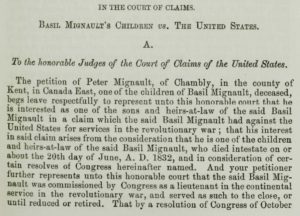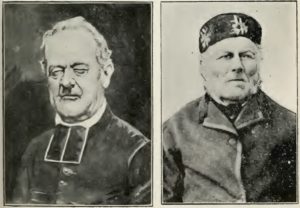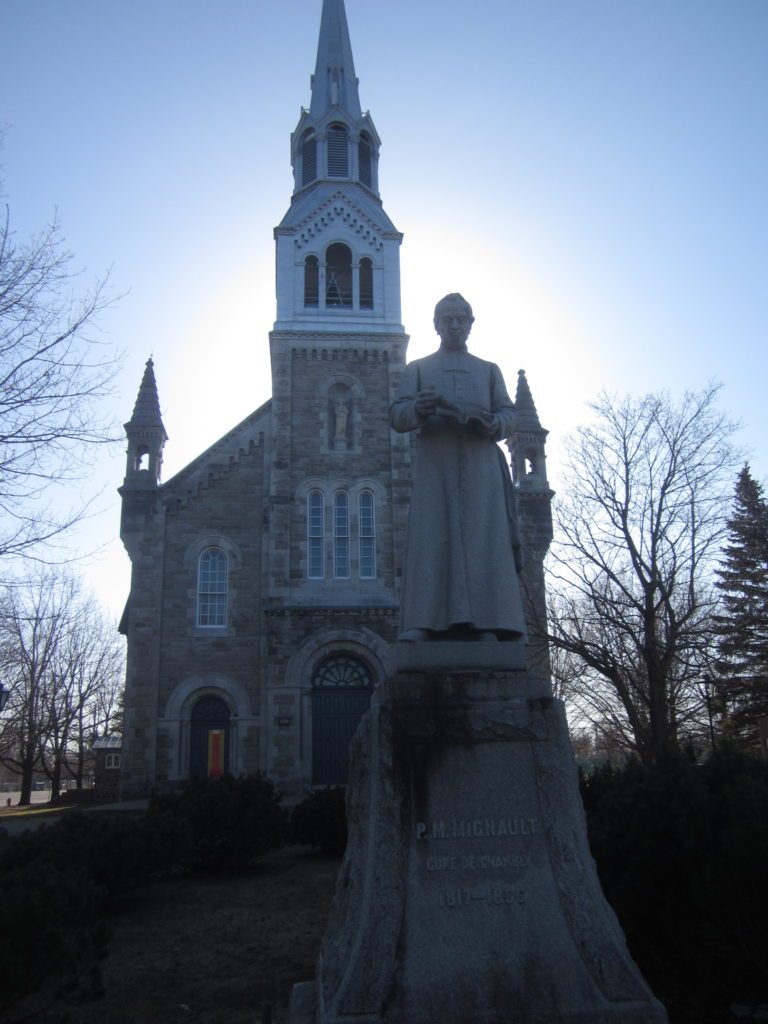Revolutionary War veteran Clément Gosselin was not alone. Basile Mignault, too, fought in the ranks of the Continental Army. Both would spend the better part of the post-war period in Canada, although Mignault could claim a more settled existence.
Indeed, while Gosselin travelled as far as Yorktown, where he was injured, his counterpart’s war was essentially over when the Continental Congress adopted its Resolution of Independence. Briefly a lieutenant of the revolutionary army, Mignault chose to remain in the Province of Quebec as a British counter-offensive drove out the occupying force in the spring of 1776. He married, fathered at least nine children, and became a leading figure of Saint-Denis, a middling village on the Richelieu River.
We should not assume, on the basis of the brevity of his military service, that Basile Mignault’s support for the American cause was half-hearted. His Acadian roots—his father had been deported to the Southern Colonies—and his later support for Le Canadien, a newspaper founded to challenge the British governor’s administration, hint at a consistent anti-British or anti-colonial attitude. Several descendants would join the Patriotes in the midst of the Rebellion of 1837.

In fact, the retreat of insurgent forces in 1776 did not mark the end the family’s encounters with the states that would form the Great Republic. In 1828, Mignault crossed the border, visiting Rouses Point at the northeastern tip of New York State, on the shores of Lake Champlain. He readily declared himself a veteran of the Continental Army and sought, with the help of attorney Calvin Averill, to obtain proper compensation for services rendered more than a half-century earlier. Mignault would die several years later, his efforts still unfulfilled. But his many children and grandchildren were ready to take the baton, even if many entered the professions and seem to have done perfectly well for themselves.
Pierre-Marie Mignault, a son, took the lead, not least because he had the capital and status to do so. Basile may have defied the ecclesiastical authorities of his province when joining the revolutionary forces; that did not signal definitive estrangement from the Roman Catholic Church. Pierre became a priest. For more than forty years, he tended to the spiritual needs of Catholics in Chambly, located roughly half-way between Saint-Denis and the international border.

He inherited his father’s interest in the United States. In the 1850s, it was Pierre who led the family’s quest for the funds that Congress apparently still owed them. By then, the parish priest was well-acquainted with New York State and Vermont. As a missionary he travelled widely to celebrate Mass and to provide the sacraments to some of the earliest French-Canadian expatriates—the “advanced guard” of the grande saignée. He helped to organize the first Canadian “national” parish in Burlington, established in 1850, and, after providing valuable services in the United States’ northern dioceses, he obtained from Pope Pius IX the title of apostolic vicar.
The pursuit of cultural and economic capital, or status, in the United States, among members of the Mignault clan survived Pierre’s death in 1868. Pierre-Basile, born to a relative in Worcester, Massachusetts, returned to the “old country” and became a justice of the Canadian Supreme Court. Arthur Mignault practiced medicine in the United States, made a small fortune in pharmaceuticals and, in his native land, helped to found the French-Canadian 22nd Battalion during the First World War. Evidently, one could embrace the resources offered by the United States without sacrificing an inherited identity or the promise of the homeland.

These cases and many more, from patriarch Basile through his many descendants, help to shed light on an overlooked aspect of French-Canadian encounters with the United States, which stretch far beyond mill life in Fall River, Lowell, and Manchester. From an early date, the Richelieu River–Lake Champlain axis served as a major site of exchange between the Canadiens and their neighbours. The varied dimensions of those exchanges still require a great deal of research, but the rewards will no doubt be numerous.
You can read more about this fascinating family in “Le cas particulier de la famille Mignault: Prospection d’une histoire transnationale” in the latest issue of Quebec Studies. Here is a sneak peek:
It is now apparent that the curious case of Basile Mignault and his descendants, though unique in some respects, invites scrutiny of the standard narrative of Quebec’s relationship with the United States. Studies focused on the “grande saignée” and beginning in the 1860s fail to capture the transnational encounters in such borderlands as the Champlain–Richelieu axis. And just like the border, Canadian and American identities as we know them today took time to crystallize.
After 1840, the dominant political discourse of Canada East (later Quebec) was both anti-revolutionary and anti-republican—it told of an ascendant Roman Catholic faith that could flourish under the perfectly balanced British Constitution. Of course, that narrative relegated to near-insignificance the Patriotes of 1837 and the Patriots of 1775-1776, both groups having derogated from their bishops’ orders. By rescuing from historical margins these individuals and their fascinating story, historians are well placed to re-evaluate national myths, for our current geopolitical definitions deviate substantially from early-nineteenth-century experiences.
For decades, the boundary line along the forty-fifth parallel could hardly have been more artificial. To our narrative of Canadian and American national development, then, we must add a transnational approach that takes these vast sites of exchange into account. After all, these are two countries that share a common history which, if not entirely republican and revolutionary, remains indivisible.
Further Reading
From Archive.org, J.-B.-A. Allaire’s Histoire de la paroisse de Saint-Denis-sur-Richelieu (Canada) and J. O. Dion’s Souvenir du Révérend Pierre Marie Migneault.
A biography of Pierre-Marie Mignault in the Dictionary of Canadian Biography.
Mason Wade, “Some Aspects of the Relations of French Canada with the United States,” Report of the Annual Meeting of the Canadian Historical Association, vol. 23 (1944), 16-39. Full version here.
Thank you for writing this story. (Jean) Basile Mignault is my ancestral great-grandfather.
Do you know if any English translations exist for Allaire’s ‘Histoire de la paroisse de Saint-Denis-sur-Richelieu (Canada)’ ? I grew up in an anglophone household in Port Arthur, Ontario (now Thunder Bay) and so ability to read French is fairly limited.
Kindest Regards
Dear Wade, thank you for reaching out. The Mignault family has such a fascinating history spanning generations – centuries, even. I wish there was an English edition. To my knowledge there isn’t. It’s actually a fairly obscure book. You could try opening the digital version in plain text (by clicking on “Full Text” in the right-hand menu when accessing it on Archive.org) and then copying and pasting into Google Translate.
Thanks very much, I will give give the Google Translate a try.
Cheers and Regards,
Wade
After many many years of searching, I now know that I am also a descendant of Jean Basile Mignault. It’s been a while since you posted this but if you (still) need help, I will gladly help you. Just let me know!
PS: What a fascinating story! Thank you M. Lacroix for your excellent work!
Great article about the Mignault family. I too am a direct descendant.
Francia Mignault
Newnan Georgia
Jean-Basile Mignault is the son of Jean-Etienne Mignault, an Acadian deported (1755). Jean-Etienne managed to return to Quebec where he participated in the Battle of the Plains of Abraham.Jean-Basile was born in Acadia in 1755. During the deportation, her mother, Marie-Madeleine Cormier, left Acadia and settled in Quebec City, where her husband joined her in late 1756 and early 1757. It can indeed be said that Jean-Basile had a certain resentment towards the British regime.That said, it seems that Jean-Basile’s request was finally accepted by the United States House Committee on Revolutionary Pensions following Pierre-Marie’s representations and a brief. paper presented by Mr. Hickman at the 1st meeting of the 35th US Congress. Many of Jean-Basile’s and Josephte’s grandchildren played important roles in the community, both civil and religious. several practiced medicine in the United States and some participated in the Civil War with the Northern army. Many French Canadians participated in the Revolutionary War and the Civil War
I am wondering if and where Father Mignault may have deposited records of the sacraments he administered in the Plattsburgh area for instance. My Jean-Baptist Garant and and Emerance Adam families were there by Feb 1849 when their first child Julia was born but her baptism and their marriage are not recorded at St. Peter’s, Plattsburg.
Hi Susan,
That’s a tough one. We find Fr. Mignault’s name repeatedly in Chambly’s records in February and March 1849. I’m not sure whether he would have had sufficient time to visit Clinton County communities during that time. With one exception, the Garant name does not appear in Chambly records during those months (it’s a Marie Anne Alphonsine whose parents were not in Plattsburgh). I suspect Mignault’s missionary work was not recorded in Chambly parish registers. The acts may have ended up at the Diocese of Albany, under whose jurisdiction Plattsburgh fell before the 1870s. There were several other missionaries operating from parishes in Lower Canada, too, which might complicate the task.
I should also add that it was not uncommon for migrant parents to have their children baptized in the parish of origin, while visiting family for instance. It may be worth looking wherever Garant and Adam originated. I wish I could be of greater assistance. Good luck!